AMA EC's Financial Stewardship - Latest Data
#1

Thread Starter
Now that the AMA's 2022 IRS990 is displayed on public website (note 1), I can now publish my latest analysis.
Big picture, the inflation adjusted IR990 data tells a clear story. The EC appears to be doing nothing to change the trajectory of the organization's finances.
Inflation adjusted membership revenue is down. Inflation adjusted net assets are down. Inflation adjusted personnel costs (largest single expense) are up. Yet another year, they outspent (significantly) the revenue. And cost cutting has not kept up with revenue decline (hence regular annual deficit spending).
These slides are the type of information I provide when I do an initial analysis of an organization's performance. I've also added a question I think the EC should answer in response to the data (trends more importantly) on each slide. If the AMA is going to survive past October 2038 (see data), I think the EVPs need to be getting asked these questions - OFTEN.
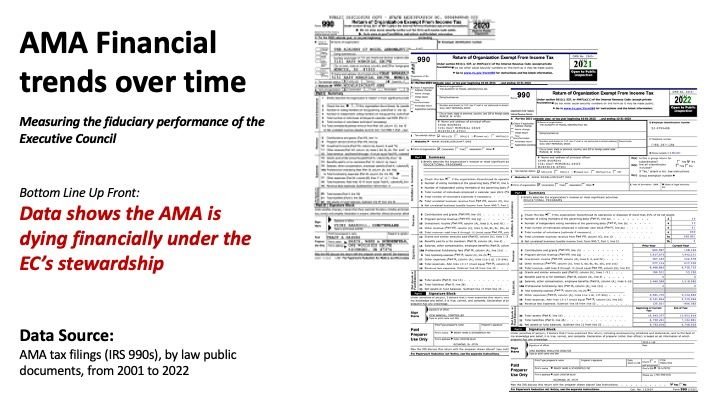
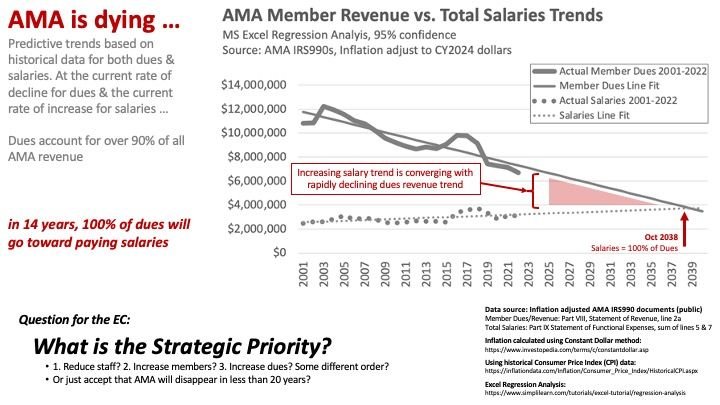
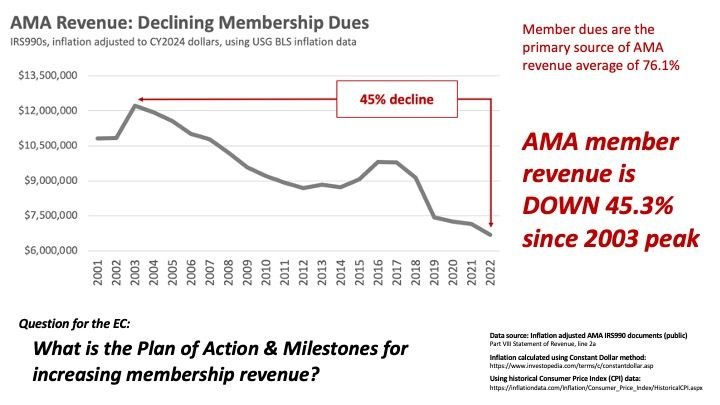
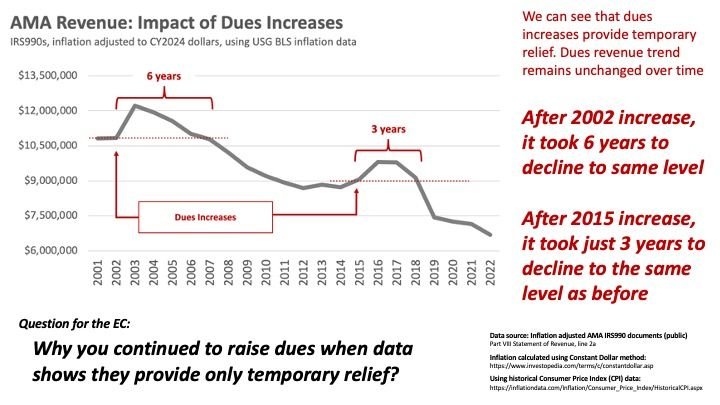
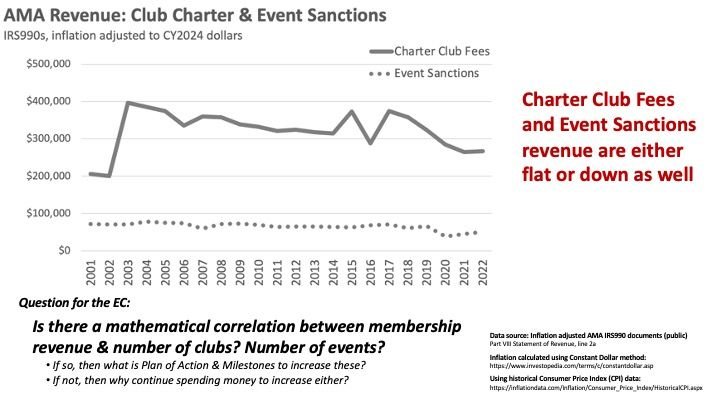
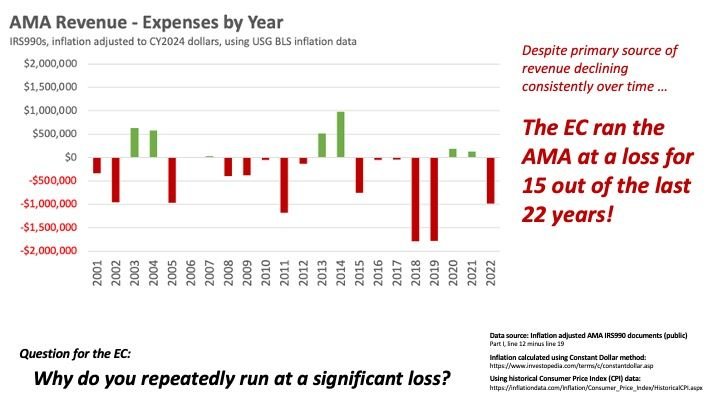

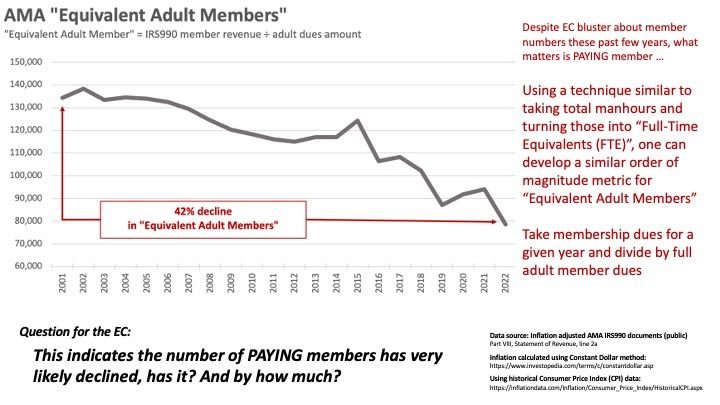

Note 1:
EIN: 52-0799408
https://beta.candid.org/profile/7749791
Big picture, the inflation adjusted IR990 data tells a clear story. The EC appears to be doing nothing to change the trajectory of the organization's finances.
Inflation adjusted membership revenue is down. Inflation adjusted net assets are down. Inflation adjusted personnel costs (largest single expense) are up. Yet another year, they outspent (significantly) the revenue. And cost cutting has not kept up with revenue decline (hence regular annual deficit spending).
These slides are the type of information I provide when I do an initial analysis of an organization's performance. I've also added a question I think the EC should answer in response to the data (trends more importantly) on each slide. If the AMA is going to survive past October 2038 (see data), I think the EVPs need to be getting asked these questions - OFTEN.









Note 1:
EIN: 52-0799408
https://beta.candid.org/profile/7749791
#3

Thread Starter
That appears to be what the EC is doing, sleeping through the financial decline.
This year's data shows the point where 100% of dues goes to pay salaries has moved to the left by a full year (first slide after title slide). When projections (curve fits) are done based on the CY2021 and earlier tax returns, the two lines cross in October 2039. Once the the CY2022 data was added to the model, they now cross a full year earlier in October 2038.
Unless the EC starts doing something dramatically different, the AMA won't have money to do anything except pay for a the Taj-Muncie staff.
(added - Salary + Benefits + Insurance trends vs. Member Dues Trends - convergence)
And in just 7 years, 100% of member dues will pay for three things: Taj-Muncie Salaries, Taj-Muncie Benefits, and Insurance. Is the EC even aware of these trends? What are they doing about it?
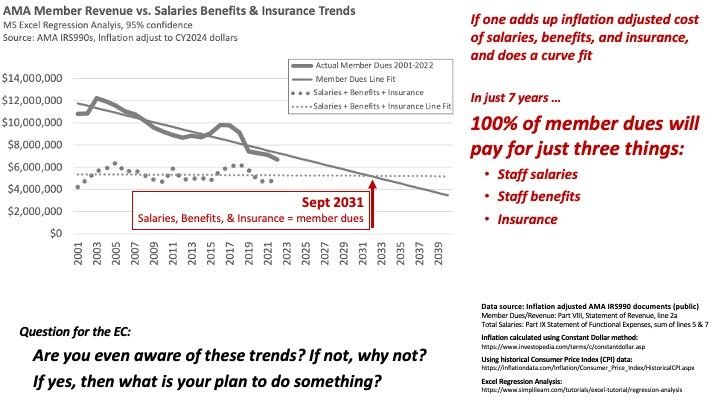
This year's data shows the point where 100% of dues goes to pay salaries has moved to the left by a full year (first slide after title slide). When projections (curve fits) are done based on the CY2021 and earlier tax returns, the two lines cross in October 2039. Once the the CY2022 data was added to the model, they now cross a full year earlier in October 2038.
Unless the EC starts doing something dramatically different, the AMA won't have money to do anything except pay for a the Taj-Muncie staff.
(added - Salary + Benefits + Insurance trends vs. Member Dues Trends - convergence)
And in just 7 years, 100% of member dues will pay for three things: Taj-Muncie Salaries, Taj-Muncie Benefits, and Insurance. Is the EC even aware of these trends? What are they doing about it?

Last edited by franklin_m; 08-17-2024 at 05:44 AM. Reason: Added additional chart
#5

Thread Starter
^^^^ In other words: "Ignore the data, the trends, the actual performance of the 'business' that is AMA. And for the sake of God, don't dare ask us hard questions or hold us accountable for our business acumen or making good decisions with your dues."
#6

My Feedback: (29)
I get that for whatever reason you are not happy with what you get for your dues but I am. For the past 45 years I have had liability insurance that will cover me in the event if an accident. In my case it is not secondary as my renters insurance does not cover my modeling activities. Thanks to AMA lobbying I am able to fly my pattern and soaring competitions legally. I can fly at any number of AMA FRIAs without RID. In fact, right now Iím waiting for my In n Out burger after flying in Dallas Oregon as a guest. All this for $85 to me is a bargain. I would have zero issues paying $200 a year for the same level of ď product ď. If/when the AMA goes under then the clubs and SIGs will jump in. The SIGs are pretty much providing everything already except for the insurance.
#7

Thread Starter
I get that for whatever reason you are not happy with what you get for your dues but I am. For the past 45 years I have had liability insurance that will cover me in the event if an accident. In my case it is not secondary as my renters insurance does not cover my modeling activities. Thanks to AMA lobbying I am able to fly my pattern and soaring competitions legally. I can fly at any number of AMA FRIAs without RID. In fact, right now Iím waiting for my In n Out burger after flying in Dallas Oregon as a guest. All this for $85 to me is a bargain. I would have zero issues paying $200 a year for the same level of ď product ď. If/when the AMA goes under then the clubs and SIGs will jump in. The SIGs are pretty much providing everything already except for the insurance.
#8
The other option is, if the above is true, that perhaps they (the EC) fully realize it's just a matter of time, and are gonna "ride the train till the wheels fall off".
While your figures plainly show severe budget cutting is in order, I do believe that when the membership number dwindles low enough, it'll end when there ain't enough buying power (membership numbers) for the insurance company to justify writing a group policy for.
My bottom line opinion, while the EC ain't helping matters, the changing times (and changing face of the hobby itself) weren't gonna see it still relevant 20 or 30 years from now anyway
While your figures plainly show severe budget cutting is in order, I do believe that when the membership number dwindles low enough, it'll end when there ain't enough buying power (membership numbers) for the insurance company to justify writing a group policy for.
My bottom line opinion, while the EC ain't helping matters, the changing times (and changing face of the hobby itself) weren't gonna see it still relevant 20 or 30 years from now anyway

#9

Thread Starter
The other option is, if the above is true, that perhaps they (the EC) fully realize it's just a matter of time, and are gonna "ride the train till the wheels fall off".
While your figures plainly show severe budget cutting is in order, I do believe that when the membership number dwindles low enough, it'll end when there ain't enough buying power (membership numbers) for the insurance company to justify writing a group policy for.
My bottom line opinion, while the EC ain't helping matters, the changing times (and changing face of the hobby itself) weren't gonna see it still relevant 20 or 30 years from now anyway
While your figures plainly show severe budget cutting is in order, I do believe that when the membership number dwindles low enough, it'll end when there ain't enough buying power (membership numbers) for the insurance company to justify writing a group policy for.
My bottom line opinion, while the EC ain't helping matters, the changing times (and changing face of the hobby itself) weren't gonna see it still relevant 20 or 30 years from now anyway

This was the first year that I combined salaries, benefits, and insurance trends and compared them against dues. I was shocked to see that they converge in just 7 years. That doesn't give them much time to make the kind of changes necessary, and of course the longer they wait the more extreme those changes will need to be. And we only need to look at how long it took to actually end the park flyer mag to see the decision cycles are measured in geological time scales.
#10

The question is will you be spending $200 a year total across all your clubs and SIGs or a similar amount for each? Regardless, will enough other people be willing to spend that kind of money? I personally don't think so, which is why I genuinely want to see AMA make the changes necessary to survive. I doubt they will, for I fear they're too emotionally attached to the business model that worked 40 years ago and just can't recognize there isn't the same demand for the AMA product today.
Last edited by fliers1; 08-18-2024 at 05:23 AM.
#11

My Feedback: (29)
The North American aviation industry is on the brink of facing an anticipated shortage of aviation mechanics in 2023, a long-forecasted situation now coming to fruition. The impact of aging baby boomers and a limited influx of Generation Z workers is manifesting within the labor pool, notably affecting licensed and unlicensed workers responsible for aircraft maintenance and repair services. With the anticipated demand surge for maintenance, repair, and overhaul services, a shortfall of 12,000 to 18,000 aviation maintenance workers is predicted. This deficit is projected to persist and worsen over the coming decade, potentially leading to flight reductions, delays, cancellations, or the need for airlines to bolster spare aircraft and parts inventory to compensate.
The escalating global demand for air travel coincides with the rapid evolution of aircraft technology, introducing challenges and opportunities for the aviation sector. Economic growth, expanding middle-class populations, and enhanced global connectivity are fueling the surge in air travel, straining aviation infrastructure and operations. Simultaneously, advanced avionics, composite materials, and sophisticated aircraft systems are enhancing efficiency and passenger comfort. However, this technological advancement poses challenges to infrastructure and necessitates a proficient workforce capable of handling, maintaining, and troubleshooting these complex systems. An imminent challenge arises from an aging workforce, with many aircraft mechanics approaching retirement, prompting the need for specialized training programs to bridge the impending skills gap. The shortage of skilled personnel presents a risk to upholding industry standards amidst the complexities of modern aircraft technology.
Itís not difficult to realize that as much as some of us love our hobby, it is a dying hobby. Not because of the regulations, not because the AMA is mis managed but because there is not enough interest to support our hobby. Look at what that lack of interest has done on the business side, in the last 35 years we have lost around 80% of our domestic hobby manufacturers and retail outlets including mail order. As it applies to AMA, my thought is they may realize that model airplanes is no longer a viable business. Why revamp the organization if the hobby has no long term future?
#12

Thread Starter
The North American aviation industry is on the brink of facing an anticipated shortage of aviation mechanics in 2023, a long-forecasted situation now coming to fruition. The impact of aging baby boomers and a limited influx of Generation Z workers is manifesting within the labor pool, notably affecting licensed and unlicensed workers responsible for aircraft maintenance and repair services. With the anticipated demand surge for maintenance, repair, and overhaul services, a shortfall of 12,000 to 18,000 aviation maintenance workers is predicted. This deficit is projected to persist and worsen over the coming decade, potentially leading to flight reductions, delays, cancellations, or the need for airlines to bolster spare aircraft and parts inventory to compensate.
The escalating global demand for air travel coincides with the rapid evolution of aircraft technology, introducing challenges and opportunities for the aviation sector. Economic growth, expanding middle-class populations, and enhanced global connectivity are fueling the surge in air travel, straining aviation infrastructure and operations. Simultaneously, advanced avionics, composite materials, and sophisticated aircraft systems are enhancing efficiency and passenger comfort. However, this technological advancement poses challenges to infrastructure and necessitates a proficient workforce capable of handling, maintaining, and troubleshooting these complex systems. An imminent challenge arises from an aging workforce, with many aircraft mechanics approaching retirement, prompting the need for specialized training programs to bridge the impending skills gap. The shortage of skilled personnel presents a risk to upholding industry standards amidst the complexities of modern aircraft technology.
The escalating global demand for air travel coincides with the rapid evolution of aircraft technology, introducing challenges and opportunities for the aviation sector. Economic growth, expanding middle-class populations, and enhanced global connectivity are fueling the surge in air travel, straining aviation infrastructure and operations. Simultaneously, advanced avionics, composite materials, and sophisticated aircraft systems are enhancing efficiency and passenger comfort. However, this technological advancement poses challenges to infrastructure and necessitates a proficient workforce capable of handling, maintaining, and troubleshooting these complex systems. An imminent challenge arises from an aging workforce, with many aircraft mechanics approaching retirement, prompting the need for specialized training programs to bridge the impending skills gap. The shortage of skilled personnel presents a risk to upholding industry standards amidst the complexities of modern aircraft technology.
Itís not difficult to realize that as much as some of us love our hobby, it is a dying hobby. Not because of the regulations, not because the AMA is mis managed but because there is not enough interest to support our hobby. Look at what that lack of interest has done on the business side, in the last 35 years we have lost around 80% of our domestic hobby manufacturers and retail outlets including mail order. As it applies to AMA, my thought is they may realize that model airplanes is no longer a viable business. Why revamp the organization if the hobby has no long term future?
Regardless, the AMA's financial trends are undeniable. Perhaps earlier posters are correct, and they're just going to ride it into the ground. Speaking of ground, I wonder what will happen to Taj-Muncie once they can no longer afford it (approx 7 years - or sooner - when 100% of dues is consumed paying for staff, insurance, and benefits).
#13

My Feedback: (29)
Unfortunately you are going to refuse to consider this info but Iíll waste a few more minutes with you.
The Flite Test business model is not sustainable. It relies on park flying which in most communities is outlawed. It also does not create life long modelers, most humans are social people. The Flite Test model doesnít lead to the same degree of social interaction that the AMA clubs offer. That social interaction is what keeps the interest level high. Going out alone or with a couple flying buddies doesnít offer the same. The same applies to the loss of brick and mortar hobby shops. There is no longer anyone ď selling ď the enthusiasm ď for the hobby. The decline of the hobby started when hobby shops started folding.
If your history repeats, you will just blow this off and mount some sort of rebuttal without any consideration to what has been offered by somone with 45 years of experience. This is why very few take you seriously. If you want to be heard, you have to hear others as well.
The Flite Test business model is not sustainable. It relies on park flying which in most communities is outlawed. It also does not create life long modelers, most humans are social people. The Flite Test model doesnít lead to the same degree of social interaction that the AMA clubs offer. That social interaction is what keeps the interest level high. Going out alone or with a couple flying buddies doesnít offer the same. The same applies to the loss of brick and mortar hobby shops. There is no longer anyone ď selling ď the enthusiasm ď for the hobby. The decline of the hobby started when hobby shops started folding.
If your history repeats, you will just blow this off and mount some sort of rebuttal without any consideration to what has been offered by somone with 45 years of experience. This is why very few take you seriously. If you want to be heard, you have to hear others as well.
#14

Thread Starter
It also does not create life long modelers, most humans are social people. The Flite Test model doesn’t lead to the same degree of social interaction that the AMA clubs offer. That social interaction is what keeps the interest level high. Going out alone or with a couple flying buddies doesn’t offer the same.
I fundamentally think that people just aren't interested in the social aspects as much as you would like us to believe. I think the numbers tell the story. I just checked, and here's some measures of the value of AMA vs. FliteTest:
YouT*be: FliteTest has 2,140,000 subscribers, AMA has 44,700 (48:1)
Faceb**k: FliteTest has 514,000 subscribers, AMA has 64,000 (8:1)
Instagr*m: FliteTest has 143,000 followers, AMA has 14,200 (10:1)
By these measures, it's clear that in terms of interest in their content, FliteTest enjoys a substantial advantage. Does interest in content correlate with interest in the hobby? Not sure. But it's certainly not a good news story for the "traditional model aviation" product and the social model of clubs that AMA is "selling."
If your history repeats, you will just blow this off and mount some sort of rebuttal without any consideration to what has been offered by somone with 45 years of experience. This is why very few take you seriously. If you want to be heard, you have to hear others as well.
You complain that I'm unwilling to hear you - are you willing to apply that same standard to yourself? Are you willing to consider that maybe, just maybe, the EC is too mired in the old way of thinking about the hobby, the social interaction aspect you mentioned, and, as a result have failed to adapt and are headed the way of other businesses that failed to adapt to change?
Last edited by franklin_m; 08-18-2024 at 09:04 AM.
#15

My Feedback: (29)
I'd be interested in supporting data for the statement "...most communities is outlawed."
Being that it is not possible to follow either AMA or Flite Test safety guidelines ď establish safety line ď Iíd say flying in a park or schoolyard that has public access is illegal.
You equate social interaction with interest in the hobby. I do not share that belief. There are plenty of people who seem perfectly fine flying by themselves or with a friend, at least as evidenced by the plethora of videos posted. Something else to consider is that if social interaction, via clubs, is AMA's competitive advantage - what generates the 'interest' - then why does AMA appear to be having difficulty retaining first time members? One would think that if the social thing was all you make it out to be, getting the repeat business would be easy.
I fundamentally think that people just aren't interested in the social aspects as much as you would like us to believe. I think the numbers tell the story. I just checked, and here's some measures of the value of AMA vs. FliteTest:
YouT*be: FliteTest has 2,140,000 subscribers, AMA has 44,700 (48:1)
Faceb**k: FliteTest has 514,000 subscribers, AMA has 64,000 (8:1)
Instagr*m: FliteTest has 143,000 followers, AMA has 14,200 (10:1)
LOL, all those subscribers does not translate into R/C pilots. IMO itís people sitting at home. Not to mention that YT, FB and Insta are international formats where AMA has interest to US residents only.
By these measures, it's clear that in terms of interest in their content, FliteTest enjoys a substantial advantage. Does interest in content correlate with interest in the hobby? Not sure. But it's certainly not a good news story for the "traditional model aviation" product and the social model of clubs that AMA is "selling."
Perhaps, but I suspect it comes down to economics. They couldn't compete.
You have 45 years experience in traditional model aviation. Ok. Noted.
You complain that I'm unwilling to hear you - are you willing to apply that same standard to yourself? Are you willing to consider that maybe, just maybe, the EC is too mired in the old way of thinking about the hobby, the social interaction aspect you mentioned, and, as a result have failed to adapt and are headed the way of other businesses that failed to adapt to change?
Being that it is not possible to follow either AMA or Flite Test safety guidelines ď establish safety line ď Iíd say flying in a park or schoolyard that has public access is illegal.
You equate social interaction with interest in the hobby. I do not share that belief. There are plenty of people who seem perfectly fine flying by themselves or with a friend, at least as evidenced by the plethora of videos posted. Something else to consider is that if social interaction, via clubs, is AMA's competitive advantage - what generates the 'interest' - then why does AMA appear to be having difficulty retaining first time members? One would think that if the social thing was all you make it out to be, getting the repeat business would be easy.
I fundamentally think that people just aren't interested in the social aspects as much as you would like us to believe. I think the numbers tell the story. I just checked, and here's some measures of the value of AMA vs. FliteTest:
YouT*be: FliteTest has 2,140,000 subscribers, AMA has 44,700 (48:1)
Faceb**k: FliteTest has 514,000 subscribers, AMA has 64,000 (8:1)
Instagr*m: FliteTest has 143,000 followers, AMA has 14,200 (10:1)
LOL, all those subscribers does not translate into R/C pilots. IMO itís people sitting at home. Not to mention that YT, FB and Insta are international formats where AMA has interest to US residents only.
By these measures, it's clear that in terms of interest in their content, FliteTest enjoys a substantial advantage. Does interest in content correlate with interest in the hobby? Not sure. But it's certainly not a good news story for the "traditional model aviation" product and the social model of clubs that AMA is "selling."
Perhaps, but I suspect it comes down to economics. They couldn't compete.
You have 45 years experience in traditional model aviation. Ok. Noted.
You complain that I'm unwilling to hear you - are you willing to apply that same standard to yourself? Are you willing to consider that maybe, just maybe, the EC is too mired in the old way of thinking about the hobby, the social interaction aspect you mentioned, and, as a result have failed to adapt and are headed the way of other businesses that failed to adapt to change?
#16

Thread Starter
Iv’e never denied that AMA is mis managed. In fact I have openly said just that in multiple responses to you over the years. I guess that just re enforces my comment about you reading to react as opposed to reading to understand. Trust me I consider everything you say, however given your history of spinning the data, outright lies ( SterlingD ) and lack of how the hobby operates, makes it a bit difficult for anyone to take anything you say at face value.
Iv’e never denied that AMA is mis managed. In fact I have openly said just that in multiple responses to you over the years. I guess that just re enforces my comment about you reading to react as opposed to reading to understand. Trust me I consider everything you say, however given your history of spinning the data, outright lies ( SterlingD ) and lack of how the hobby operates, makes it a bit difficult for anyone to take anything you say at face value.
Regardless of what you want to believe, or what you see through the soda straw perspective of your expeirence there in Oregon, the numbers say the AMA is dying. In the months ahead, the EC minutes will provide evidence of the EC's thinking. If they dramatically start cutting costs, then we'll know they're trying to save the organization. If they keep doing more of the same, then we'll know they're going to ride it into the ground over the next seven years.
Last edited by franklin_m; 08-18-2024 at 09:58 AM.
#17

My Feedback: (29)
My soda straw view from Oregon, LOL. Great demonstration of how you donít pay attention to what others post here. Iíve only been in Oregon for 5 years. Iíve also posted that in the Ď80s I managed the largest hobby shop in California. Iíve mentioned working hobby shows in multiple locations in the country. More of your BS spin!
#19

Thread Starter
My soda straw view from Oregon, LOL. Great demonstration of how you donít pay attention to what others post here. Iíve only been in Oregon for 5 years. Iíve also posted that in the Ď80s I managed the largest hobby shop in California. Iíve mentioned working hobby shows in multiple locations in the country. More of your BS spin!
By the way, that hobby shop in California. Is it still in business?
#21

Thread Starter
According to one of your buds on RCG (Thomas B), said theirs was 40-50%. In another post, someone named babble fish said 10-30%. Another gent, Mark M said profit on a servo is about 10%.
But regardless, I don't know a specific number. I'll push the "I believe" button that it's small. And your point being what?
#23

Thread Starter
But I do know that a successful business ultimately comes down to inflation adjusted revenue - inflation adjusted expenses and the trend over time. After that, it's just a matter of looking into details where changes can (or must) be made. Pretty simple really.
#25
The most disappointing thing I have found since returning to the hobby is the shops are gone, and clubs have dwindled to near nothing. I am missing the stops I used to make at the Hobby shops and the friends that I have made at the clubs. I think both items are victims of the internet sales pressures. It is a shame









